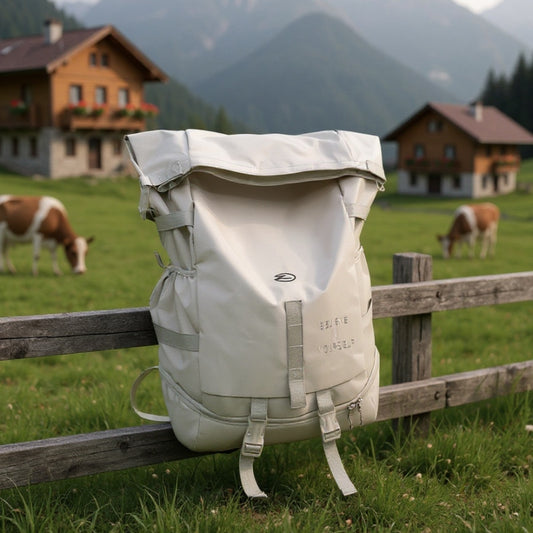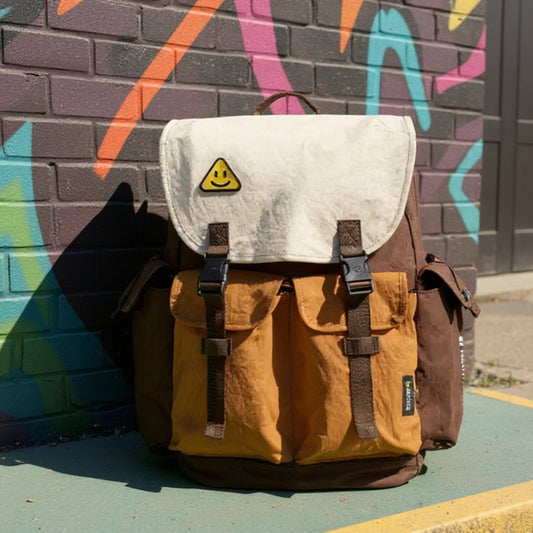College Backpack Guide: Do People Still Wear Backpacks to College?
Share
Do people still wear backpacks to college? Absolutely. But here's what happens: by sophomore year, your backpack doesn't work anymore. The laptop compartment is too tight, you're digging through one giant pocket for your keys, and carrying it through back-to-back classes leaves your shoulders aching. It wasn't a bad choice—it just wasn't built for four years of college life.
So you buy another one. Sometimes a third. Three bags, four years, $200+ gone.
What if you only needed one college backpack for all four years?
This isn't another "top 10 backpacks" list. It's about understanding what actually makes a college backpack last—from freshman dorm chaos to senior job interviews. We're talking about a 26L water-resistant design that keeps your laptop safe in a sudden drizzle, stays light enough for marathon class days, and looks good doing it.
Let's break it down.

Why College Students Still Need Backpacks (Just Better Ones)
The "backpacks are outdated" argument usually goes like this: classes are digital now, so why carry anything heavy? Just grab a tote bag or messenger bag and call it a day.
Here's why that doesn't work in real college life.
Your laptop costs more than your textbooks ever did. A $1,500 MacBook sitting in a thin tote bag on a rainy walk to the library? That's a $1,500 risk. College backpacks with padded laptop compartments aren't overkill—they're basic protection for your most expensive tool. Add a water bottle, charger, notebook, and suddenly that "just a laptop" becomes 15 pounds you're carrying for 6+ hours between classes.
You're not just a student anymore. Monday: 8 AM lecture. Tuesday: part-time job interview. Wednesday: gym after your lab. Thursday: group project at a coffee shop. One day you need textbooks, the next day you need business casual clothes and a portfolio. A proper college backpack handles all of it without looking out of place. Tote bags are great—until you're speed-walking across campus in the rain with a laptop, water bottle, and yesterday's gym clothes.
Commuting is still a thing. If you're a walking/biking student or taking public transport, weight distribution matters. Messenger bags look cool for 20 minutes, then your shoulder starts screaming. Backpacks spread the load across both shoulders—especially important when you're carrying 20-25 pounds of "just digital" college life.
The question isn't whether you need a backpack. It's whether you need one that actually works for four years.

Why Most College Backpacks Fail (And What to Look For Instead)
Let's be honest: most college backpacks fail not because they break, but because they were never designed for actual college life in the first place.
Problem 1: The Weight-Capacity Trap
Cheap backpacks give you two bad options: either they're huge (35L+) and weigh 3 pounds empty, or they're tiny (15L) and can't fit a day's worth of stuff. You end up with backpack syndrome—that dull ache in your shoulders after carrying a poorly balanced load for hours. The sweet spot? 26L capacity with lightweight construction. Enough room for a 16-inch laptop, textbooks, a change of clothes, and a water bottle—without the bag itself adding unnecessary weight. When a backpack weighs under 2 pounds empty, you're only carrying what you actually need.
Problem 2: "Functional" Doesn't Mean Ugly
Here's the dilemma: most backpacks either look good or work well, rarely both. The sleek minimalist bags can't protect your laptop from a bump. The heavily padded "tactical" ones make you look like you're prepping for a camping expedition when you're just going to Economics 101.
But you actually need both protection and style. Your college backpack goes everywhere—lecture halls, coffee shop study sessions, job interviews, weekend trips. It needs to look appropriate in all of them. Water-resistant fabric isn't just about staying dry in sudden rain—it also means the bag ages better than cheap canvas that stains and fades by midterms. Clean design, versatile colors, and smart organization mean your backpack complements your look instead of working against it.
Problem 3: The "Good Enough" Tax
A $40 backpack that lasts one year costs more than a $138 bag that lasts four years. Most students learn this the hard way: they buy budget, replace it sophomore year, maybe again junior year. By graduation, they've spent $120-150 on bags that spent more time being replaced than being used. Durability isn't about premium materials for the sake of it—it's about water-resistant zippers that don't corrode, stitching that holds under daily stress, and fabric that doesn't pill after a semester.
What to Actually Look For:
- 20-30L capacity (the Goldilocks zone for college)
- Under 2 lbs empty weight
- Dedicated laptop compartment (16-inch compatible)
- Water-resistant exterior (for sudden drizzles, not hurricanes)
- 4+ organizational pockets (so you're not digging for keys)
- Design that doesn't scream "borrowed from high school"

Take the Backpackbeat 7706 26L Backpack as an example—it hits all six of these marks without compromising on any. But the point isn't about one specific bag. It's about knowing what to look for so you're not settling for "good enough."
One Backpack, Four Years: Does Yours Actually Last?
Have you ever had your backpack zipper break during finals week? Or realized your bag looks too beat-up to bring to a job interview? Most college students don't plan to replace their backpack—it just happens when something fails.
Here's the reality: cheap backpacks show their age fast. Zippers catch, straps fray, fabric stains permanently. Within a year or two, you're shopping for a replacement—not because you wanted to, but because you have to.

What if you didn't have to replace it at all?
That's the idea behind the Backpackbeat 7706. Water-resistant fabric that wipes clean. Reinforced zippers built for daily use. A 26L design that adapts—lectures, internships, weekend trips, your first job after graduation. It's not about surviving four years. It's about being built for them from the start.
This is what long-term thinking looks like: you invest once in something designed to last, instead of buying the same thing three times. The 7706 isn't just durable—it's intentional. Every detail, from the stitching to the organization pockets, exists because college life demands it.
You buy it once. You use it for years. That's the point.
What Are Some Good College Backpacks?
Honestly? You don't need a list of 10 options. You need one that actually works.
After four years of college, here's what matters: a backpack that doesn't make you think about it. It fits your laptop, holds a full day's supplies, doesn't hurt your shoulders, and still looks decent when you need to look professional.

The Backpackbeat 7706 does exactly that. 26L capacity that handles textbooks and weekend trips. Water-resistant fabric that protects your electronics. Lightweight enough to carry all day without the shoulder ache. Four organizational pockets so you're not digging for your keys every morning.
It's not flashy. It's not trying to be the "coolest" bag on campus. It's just built to last from freshman year through graduation—and probably your first job after that.
That's what a good college backpack is: one you buy once and stop thinking about.




